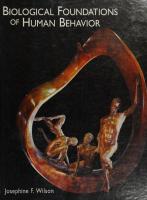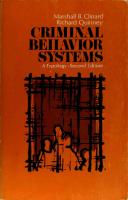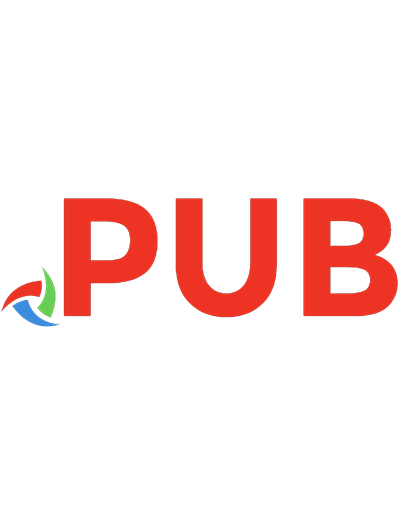Biological Influences on Criminal Behavior [2 ed.] 0367360012, 9780367360016
Biological Influences on Criminal Behavior, Second Edition is fully updated to include recent research, studies, and pub
453 86 6MB
English Pages 342 [343] Year 2019
Table of contents :
Cover
Half Title
Title Page
Copyright Page
Dedication
Table of Contents
Preface
Acknowledgments
Author
1: Biology and crime
Introduction
The question of biology, crime, and the environment
Is writing learned environmentally or controlled genetically?
Is there more to biology than just genetics?
Resistance to biological explanations
The promise of biological research
1. Phenylketonuria
2. Cystic fibrosis
3. Serotonin
Some obvious examples of biology’s effect on behavior
Puberty
Pregnancy
Menstruation
Resistance to biological criminology
The history of biology and crime
Franz Gall and phrenology, eighteenth and early nineteenth century
Lombroso and atavisms, nineteenth century
Francis Galton and the start of eugenics
The eugenics movement
Eugenics in the latter part of the twentieth century
Immigration and intelligence quotient testing
Endomorphs, mesomorphs, and ectomorphs
Determinism
Racism and sexism
Mental illness and medicalization of crime
Other cautions that must be considered
Predisposition
What is crime?
Cautions for all criminological research
1. Adolescence
2. Research samples
3. Underreporting of crimes
4. Self-reporting
5. Consent
The future of biosocial criminology
Conclusion
Questions for further study and discussion
References
2: Evolution, natural selection, and behavior
Introduction
Natural selection
Types of adaptations
Structural modifications
Biochemical pathways
Behavioral adaptations
Conditions required for natural selection to act
1. Variation
2. Heritability
3. Fitness consequences
Constraints on natural selection
1. Adaptations are often compromises
2. Natural selection can only work on existing traits
Behavior in humans and other animals
Innate behaviors
When and where do innate behaviors occur?
In animals with no opportunity to learn
Critical to get it right the first time
Types of signs or stimuli that trigger innate behaviors
Visual
Auditory
Olfactory
Temperature
Combination of signs
Learned behaviors
Learning versus maturation
Habituation
Imprinting
Classical conditioning
Operant conditioning
Observational learning
Play
Insight learning
Natural selection and behavior
Aggression
Natural selection and crime
1. Theft and robbery
2. Assault and murder
Infanticide
Siblicide
3. Sexual assault and rape
4. Child abuse
5. Domestic violence
Evolutionary theories
Cheater theory
Variation within K-strategists
Conditional adaptation theory
Alternate adaptation theory
Evolutionary expropriative behavior
Conclusion
Questions for further study and discussion
References
3: Genetic principles
Introduction
Introduction to genetics
Meiosis
Genetics: The study of patterns of inheritance
Mendel’s experiments
Non-Mendelian types of gene interactions and inheritance patterns
Linked genes
Sex-linked traits
Incomplete dominance
Codominance
Pleiotropy
Epistasis
Polygenic inheritance
Mutations
Recessive alleles in the population
Recessive alleles and disease
Why aren’t we perfect?
Gene expression
Heritability
Conclusion
Questions for further study and discussion
References
4: Misconceptions, experimental design, and behavioral genetics
Introduction
Some misconceptions about genetics
Animal cloning
Human cloning
Does all crime have the same single cause?
XYY man: Truth and fallacy
Experimental design
Scientific method
Isolating a single variable
Sample size
Crossover studies
Replication
Double-blind studies
Studying humans
Studying behavioral genetics
Introduction to twin studies
Dizygotic twins
Monozygotic twins
Explanations for twin coincidences
Using twins to study genetic and environmental influences on behavior
Using adoption to study genetic and environmental influences on behavior
Conclusion
Questions for further study and discussion
References
5: Evidence for genetic predispositions for criminogenic behavior: Twin and adoption studies
Introduction
Twin studies
Early twin studies
Modern twin studies
Identical twins reared apart
Cautions for twin studies
Shared environment
Generalizability
Genetic additivity
Overuse of data sets
Adoption studies
Early adoption studies
Mednick’s Danish adoption studies
Bohman’s Stockholm adoption studies, 1996
Modern adoption studies
Impulsivity
Psychopathy
Substance abuse
Cautions for adoption studies
Differences between biological and adoptive parents
Late separation
Selective placement
Prenatal influences
Genetics and behavior overall
Protective factors
Family and social bonding
Resilience
Education and school experiences
Enrichment programs
Other protective factors
Conclusion
Questions for further study and discussion
References
6: Candidate genes, gene × environment interactions, and epigenetics
Introduction
Candidate genes
Attention deficit hyperactivity disorder
Conduct disorder
Schizophrenia
Interactions between genes and the environment
Gene–environment correlations
1. Passive gene–environment correlations
2. Reactive gene–environment correlations
3. Active gene–environment correlations
Gene × environment interactions
An example of G × E interactions
G × E interaction models
1. Diathesis stress model
2. Bioecological model
3. Differential susceptibility
4. Social distinction model
5. Social push model
Interventions considering G × E interactions
Epigenetics
Epigenome
1. DNA methylation
2. Histone modification or acetylation
Impact of the environment on the epigenome
Early-life adversity
Post-traumatic stress disorder
Treatment potential
Can epigenetic changes be inherited?
Cautions with epigenetics
Conclusion
Questions for further study and discussion
References
7: The chemistry of the body: The effects of hormones on behavior
Introduction
The functions of hormones
Testosterone
Testosterone exposure
Prenatal testosterone and behavior
Prenatal testosterone and criminal behavior
Prenatal testosterone and risk-taking behavior
Postpubertal testosterone and behavior
Postpubertal testosterone and criminal behavior
1. Natural testosterone levels in aggressive or criminal individuals
2. Increasing testosterone levels
3. Decreasing testosterone levels
Postpubertal testosterone and risk-taking behavior
Testosterone, competition, and dominance
Theoretical background
Competition studies
Serotonin and testosterone
Testosterone in prosocial behavior
Testosterone overall
Cortisol
Cortisol, stress, and abuse
Cortisol and antisocial behavior
Cortisol and testosterone
The dual-hormone hypothesis
Cortisol and psychopathy
Cortisol overall
Other hormones
Thyroid hormones
Menstruation
Infanticide
Conclusion
Questions for further study and discussion
References
8: The prenatal environment and birth complications
Introduction
Birth complications
Fetal development, nutrition, and pollutants
Fetal alcohol spectrum disorder
FASD and the criminal justice system
Gene × environment interactions in FASD
Intervention
Maternal smoking
Smoking’s potential effects on a fetus
Direct health risks
Poor parenting and mother–child attachment
Nicotine addiction
Maternal stress
Gene × environment interactions
Epigenetic effects
Maternal age
Maternal stress
Fetal maldevelopment and minor physical anomalies
Other birth-related difficulties
Twin births
Maternal rejection
Ethical issues
Criminalization of pregnant women in the United States
Some case examples
Conclusion
Questions for further study and discussion
References
9: The chemistry of the brain: The role of neurotransmitters on behavior
Introduction
Introduction to neurotransmitters
The mechanism of action
Serotonin
Serotonin and suicidal behavior
Serotonin, suicide, and stress
Serotonin, suicide, and stress
Serotonin and aggression
Serotonin and psychopathy
Serotonin and impulsivity
Serotonin receptor sites
The serotonin precursor, tryptophan
Selective serotonin reuptake inhibitors
Norepinephrine
Dopamine
The dopamine transporter, DAT-1
Dopamine receptor D2, DRD2
Dopamine receptor D4, DRD4
Protective factors
Dopamine and schizophrenia
Monoamine oxidase
Monoamine oxidase and aggression
MAOA and a gene × environment interaction
Other factors
Conclusion
Questions for further study and discussion
References
10: Traumatic brain injury and neurocognitive disorders
Introduction
Head injury
Frontal lobe injuries
Case examples of frontal lobe injury
Traumatic brain injuries in youth
Prevalence of young offenders with traumatic brain injury
Gender differences in youth with traumatic brain injury
Which came first, traumatic brain injury or risky behavior?
Traumatic brain injuries and schizophrenia
Impact of traumatic brain injury on youth during criminal justice proceedings
Traumatic brain injury in adults
Prevalence of traumatic brain injury in incarcerated populations
Traumatic brain injury and substance abuse
Was the traumatic brain injury causal?
Brain disorders
Case examples of organic brain disorders
Neuroimaging studies of brain abnormalities
Neuroimaging techniques
Computer tomography
Magnetic resonance imaging
Positron emission tomography
Single-photon emission computed tomography
Functional magnetic resonance imaging
Brain-imaging studies of offenders
Treatment options
Conclusion
Questions for further study and discussion
References
11: The effects of pollution, toxins, and diet on behavior
Introduction
Pollution and toxins in our environment
Lead
Effects of lead on the body
Effects of lead on antisocial behavior in children
Effects of childhood lead exposure on criminal behavior in adults
Effects of low socioeconomic status and lead
Effects of banning lead in gasoline
Effects of intervention
Recommendations to reduce environmental lead
Manganese
Manganese exposure
Effects of manganese on adults
Effect of manganese on children
The safety threshold for manganese in drinking water
Other heavy metals
Cadmium
Coexposure to pollutants
Breast milk
Mercury
Pollution overall
Diet
Hypoglycemia (low blood sugar)
Diet and supplementation
Dietary tryptophan and serotonin
Vitamins and minerals
Fatty acids
Effects of fatty acid supplementation on autism spectrum disorder
Combination of fatty acids and other supplements
Discontinuation of fatty acid supplementation
Mechanisms of fatty acid supplementation
Food additives and food allergies
Diet overall
Conclusion
Questions for further study and discussion
References
12: The role of biology in the courtroom
Introduction
Role of genetics
Judicial perceptions of genetic predispositions for criminal behavior
Public perceptions of genetic predispositions for criminal behavior
Use of genetic predispositions in court
Role of neurotransmitters
Attempts to use MAOA-L during the guilt phase of a trial
Use of MAOA-L during the sentencing phase of a trial
Use of MAOA-L during the appeal phase of a trial
Double-edged sword?
Judicial perceptions of MAOA in the courts
Public perceptions of MAOA in the courts
Concerns with the use of MAOA in court
Use of serotonin levels in court
Role of traumatic or organic brain injury
Use of traumatic brain injury or brain trauma in court
Public perceptions of neuroimaging evidence
Concerns with the use of neuroimaging in court
Role of fetal alcohol spectrum disorder
Role of biological factors overall
Conclusion
General conclusions
Questions for further study and discussion
References
Epilogue
Index
![Biological Influences on Criminal Behavior [2 ed.]
0367360012, 9780367360016](https://dokumen.pub/img/200x200/biological-influences-on-criminal-behavior-2nbsped-0367360012-9780367360016.jpg)
![Biological influences on criminal behavior [Second edition]
9780429356834, 9780367360016, 9780367417284, 0367360012, 0429356838](https://dokumen.pub/img/200x200/biological-influences-on-criminal-behavior-second-edition-9780429356834-9780367360016-9780367417284-0367360012-0429356838.jpg)



![Criminal Behavior [2 ed.]
0805848924, 9780805848922](https://dokumen.pub/img/200x200/criminal-behavior-2nbsped-0805848924-9780805848922.jpg)




